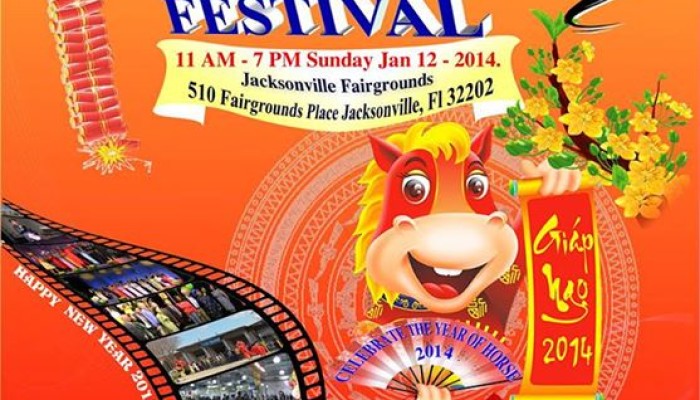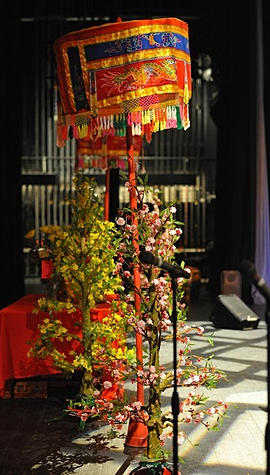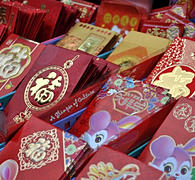
TET Festival
When: Sun Jan 12, 2014 11am to Sun Jan 12, 2014 7pm
EST
Where: Jacksonville Fairgrounds
Event Status: confirmed
Event Description: 3rd Annual Tet Festival at the Jacksonville Fairgrounds!
https://www.facebook.com/events/129223370581582/
TET Festival
The festival which best epitomizes Vietnam’s cultural identity is Vietnamese New Year or Tet.
“Tet” is the phonetic deformation of “Tiet”, a Sino Vietnamese term which means “Joint of a bamboo stern” and in a wider sense, the “beginning of a period of the year”. The passage from one period to the next may cause a meteorological disturbance (heat, rain, mist) that must be exercised by ritual sacrifices and festivities. There are many Tets throughout the year (Mid-autumn Vietnamese New Year, Cold Food Vietnamese New Year, etc.). But the most significant of all is “Vietnamese New Year”, which marks the Lunar New Year.
Vietnamese New Year occurs somewhere in the last ten days of January or the first twenty days of February, nearly halfway between winter solstice and spring equinox. Although the Lunar New Year is observed throughout East Asia, each country celebrates Vietnamese New Year in its own way in conformity with its own national psyche and cultural conditions
For the Vietnamese people, Vietnamese New Year is like a combination of Western Saint Sylvester, New Year’s Day, Christmas, Easter and Thanksgiving. It is the festival of Purity and Renewal. (http://www.vietnam-beauty.com)

Vietnamese New Year Customs
1. Clean and decorate the home
Homes are often cleaned and decorated before New Year’s Eve. Children are in charge of sweeping and scrubbing the floor. The kitchen needs to be cleaned before the 23rd night of the last month. Usually, the head of the household cleans the dust and ashes (from incense) from the ancestral altars. It is a common belief that cleaning the house will get rid of the bad fortunes associated with the old year. Some people would paint their house and decorate with festive items.
2. Literally means “getting new clothes”
This is often the most exciting part of the Vietnamese New Year among children. Parents usually purchase new clothes and shoes for their children a month prior to the New Year. However, children cannot wear their new clothes until the first day of the New Year and onward. The best outfit is always worn on the first day of the year.
3. Lunar New Year’s Eve
However, in a literal translation, it means “Passage from the Old to the New Year”. It is a common belief among Vietnamese people that there are 12 Sacred Animals from the Zodiac taking turn monitoring and controlling the affairs of the earth. Thus, Giao Thua (New Year’s Eve)is the moment of seeing the old chief (Dragon for 2000) end his ruling term and pass his power to the new chief (Snake for 2001). Giao Thua is also the time for Ong Tao (Kitchen God) to return to earth after making the report to the Jade Emperor. Every single family should offer an open-air ceremony to welcome him back to their kitchen.
4. Apricot flowers and peach flowers
Flower buds and blossoms are the symbols for new beginning. These two distinctive flowers are widely sold and purchased during Tet. Hoa Mai are the yellow apricot flowers often seen in Southern Viet Nam. Hoa Mai are more adaptable to the hot weather of southern regions, thus, it is known as the primary flower in every home. Hoa Dao are the warm pink of the peach blossoms that match well with the dry, cold weather from the North. Tet is not Tet if there is no sight of Hoa Mai (south) or Hoa Dao (north) in every home.
5. Giving away red envelopes (filled with lucky money)
This is a cultural practice that has been maintained for generations. The red envelopes symbolize luck and wealth. It is very common to see older people giving away sealed red envelopes to younger people. Reciprocally, the older ones would return good advice and words of wisdom, encouraging the younger ones to keep up with the schoolwork, live harmoniously with others, and obey their parents.
This greeting ritual and Li Xi is also known as Mung Tuoi, honoring the achievement of another year to one’s life.

Jacksonville Businesses
contractors jacksonville | jacksonville insulation | jacksonville town center | jacksonville town center restaurants | moxie kitchen jacksonville | jacksonville seo | jacksonville search engine optimization | jacksonville jewelers | Search engine optimization experts | jacksonville town center jewelry stores | pediatric doctors jacksonville | new years eve 2014



